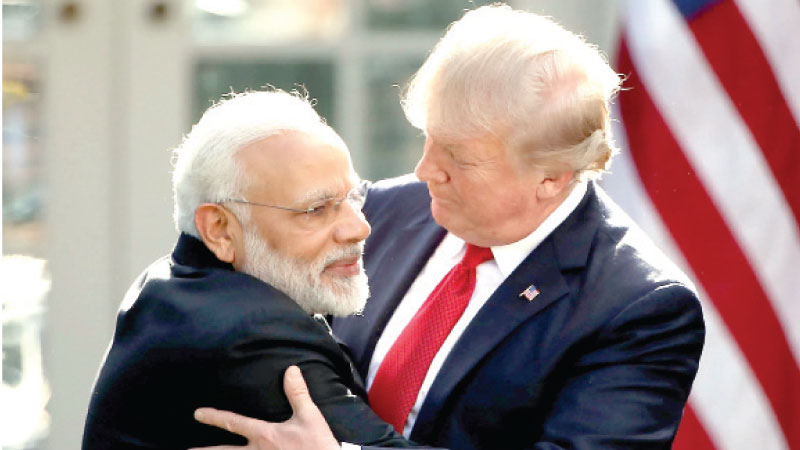During the Biden administration, India had used the space provided by America’s liberal mindedness to strike an independent foreign policy, which it called “multi-alignment” and “strategic autonomy”. India projected itself as a “Vishwabandhu” or a Global Friend to enable multi-alignment.
In the Biden era, India was able to manage striking contradictions without any adverse consequences. On the one hand, it was a key member of BRICS dominated by Russia and China and aiming to contain America’s global dominance. On the other hand, it was a “strategic partner” of the US with membership of the anti-China QUAD.
India bought oil from Russia at a concessional rate despite US sanctions on Moscow. India refused to condemn Russia’s war against Ukraine, disappointing the US and its European allies but was none the worse for it. Washington was tolerant towards India because of an over-arching need to have India on its side to contain China in South Asia and the Indian Ocean.
Even so, doubts began to be voiced in scholarly circles in the US about India’s commitment to US strategic interests. Scholars such as Ashley Tellis wondered if India was a reliable partner. Tellis wrote a widely-read piece on India’s getting more from the US than it gave the US. The former US Ambassador in India Eric Garcetti told a public gathering in Kolkata that he wondered if India was a true friend of the US as friends were expected to come to each other’s aid in times of need.
Enter Trump
Then came Donald Trump with his penchant for transactional relationships and tough talk. The geopolitical scenario changed radically. Trump’s America was not going to be polite and giving unlike Biden’s. It would bluntly demand its pound of flesh. It was going to use its dollar-based power and economic clout to impose punishing tariffs on recalcitrant countries, including India, which Trump dubbed “Tariff King.”
Indeed, the opening days of Trump’s regime were none too good for India. To begin with, Trump did not invite Prime Minister Narendra Modi for his inauguration while inviting Chinese President Xi Jinping. He threatened to slap a punishing tariff hike describing India as a difficult place to do business in. He then packed off 104 Indian illegal immigrants, chained hand and foot, back to India, causing public revulsion there.
Pleasant outcome
Notwithstanding the grim opening scene, the visit of Modi to Washington on February 12 and 13, went off well with Modi accommodating Trump’s economic demands and Trump announcing US military equipment sales and investments in India. Both leaders realised that the relationship had to be one of give and take and a strong Indo-US relationship was critical to counter China.
Modi said, “I appreciate how President Trump always keeps his country first. I do the same – that is something that we have in common.” Trump said of Modi, “He is doing a great job in India and he and I share a great friendship. We will continue to build on ties between our nations.”
Trump offered to sell the “state-of-the-art” F-35 fighter jets to India. Impressive though it might be, there could be problems. Elon Musk had tweeted on November 25, 2024, “The F-35 design was broken at the requirements level, because it was required to be too many things to too many people. This made it an expensive and complex jack of all trades, master of none. Success was never in the set of possible outcomes. And manned fighter jets are obsolete in the age of drones anyway. Will just get pilots killed.” This view was backed by Dr. Brahma Chellaney who too preferred drones to manned aircraft.
On the economic front, Modi said that the US and India are targeting US$ 500 billion bilateral trade by 2030. He said that the US and India would work together on Artificial Intelligence and semiconductors and focus on establishing strong supply chains for strategic minerals. On his part, Trump said that he expected “wonderful trade deals” and added that India is reforming its laws to welcome US nuclear technologies.
Tariff issue
Given Trump’s fixation about tariffs, Modi would have to give his nod to a significant hike in American tariffs on imports from India and lower Indian tariffs on US goods. Indeed, among Asian economies, India has a 9.5 percent weighted average effective tariff on US exports, while there is a three percent rate on India’s exports to the US. Thailand has only a 6.2 percent rate and China a 7.1 percent rate on US products.
Trump has already signed a round of what he called “reciprocal tariffs” to create a level playing field between US manufacturers and foreign competitors. He slapped 25 percent tariffs on steel and aluminium imports, to boost local production. This applies to India too. India is one of the world’s largest primary producers of aluminium and America is its top export market. India’s aluminium exports to the US, therefore, could see a drop.
Modi would have to help narrow the significant trade gap now in favour of India. US exports to India are worth US$70 billion and imports US$120 billion.
There is thus a trade deficit of US$ 50 billion in India’s favour. India would have to buy more from the US and for that, tariffs would have to be lowered. India has already agreed to buy US oil.
Anticipating Trump’s moves, in February itself, India slashed custom duties on import of American products such as high-end motorcycles and cars, and smartphone components.
This will benefit American corporate giants like Harley-Davidson, Tesla, and Apple. In 2023, India had dropped retaliatory tariffs on US almonds, apples, chickpeas, lentils and walnuts.
More recently, India allowed General Electric to partner with India-based Hindustan Aeronautics Ltd, to produce jet engines for Indian aircraft in India itself. India agreed to buy US-made armed MQ-9B Sea Guardian drones.
While it has no option but to grin and bear higher US tariff hikes, India could cushion the impact by entering into a broad trade agreement with the US. Indeed, India and the US are already aiming to sign an agreement by the end of 2025.
Defence cooperation
The US had declared China as the “strategic competitor” in its Indo-Pacific Strategy (IPS-2022) in February 2022, and simultaneously designated India as its “strategic partner” and counter weight to China. Ever since, India is granted exceptionalism and preferential treatment to enhance its technological and military potential against China.
The USA not only granted unprecedented sanction waiver to India for purchasing S-400 from Russia but also facilitated access to the Nuclear Suppliers Group (NSG). The US had entered into the 123 civil nuclear agreement besides exporting niche military capabilities to India. It concluded with India a number of military agreements including General Security of Military Information Agreement (GSOMIA); Logistic Support Agreement (LSA); Communications and Information Security Memorandum of Agreement (CISMOA) and the Basic Exchange and Cooperation Agreement for Geospatial Intelligence (BECA). The Initiative on Critical and Emerging Technologies (ICET) was launched in 2022.
Modi would have sought assurances from Trump that he would remain committed to this and that US products were not prohibitively priced.
Prior to meeting Modi, Trump signed an Executive Order directing the Department of Justice (DoJ) to pause enforcing the Foreign Corrupt Practices Act (FCPA) that prohibits American companies and foreign firms from bribing officials of foreign Governments to obtain or retain business. About FCPA Trump said: “It sounds good, but it hurts the country.” If FCPA is strictly enforced, US companies may not be able to do business in the Global South.
Under the Biden administration, Indian billionaire Gautam Adani and his company were charged for paying (with US investors’ money), US$ 265 million as bribes to Indian officials to secure solar power contracts. This may now be dropped, smoothening relations between Modi and Trump.
Illegal immigration is a key political issue bedevilling Indo-US relations since Trump came to power. The US says that there are 220,000 illegal Indian immigrants in the US. But Indians dispute this figure. However, India has said that it will take the illegals back.
Trump’s final stand on the H-1B visa regime for Indians with technical skills is not clear. Some sections of the US right wing are against giving it liberally, while others like Elon Musk and Trump are for it. The H-1B visa is a key issue for Indian middle and upper class persons, lakhs of whom make a beeline to the US year after year. And this class is Modi’s political constituency also.









